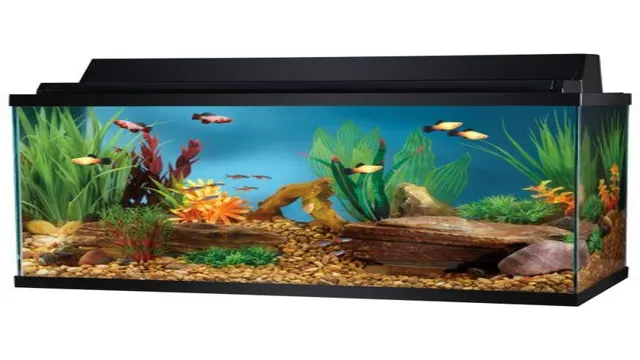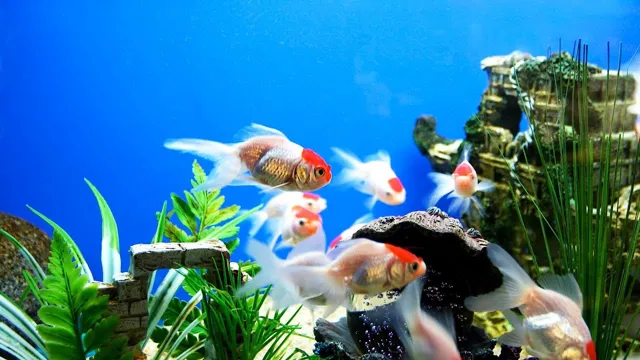Are you interested in starting your own freshwater aquarium? Look no further! Setting up a new aquarium can be overwhelming, but with the proper guidance, it can be a fun and exciting process. Creating an aquatic environment that can mimic a natural habitat can be not only aesthetically pleasing but also beneficial for your fish’s health and behavior. Just like how we need a comfortable and safe living space, our aquatic pets require a suitable environment for their wellbeing.
Imagine a cozy bedroom versus a dark and dirty room, which one would you prefer? The same goes for our fish. In this blog, we will guide you through the essential steps to set up a freshwater aquarium that’s perfect for your fishy friends. Whether you’re a beginner or an experienced fish keeper, this guide will offer you valuable insights and tips to help you get started.
So, let’s dive into the fascinating world of freshwater aquariums!
Choose the Right Tank and Location
If you’re a beginner in setting up a freshwater aquarium, choosing the right tank and location is crucial for the overall health and well-being of your fish. It’s always essential to choose a tank that’s big enough for the number of fish you have and the size they will grow to be. Choosing the right location is also important since direct sunlight can cause rapid temperature changes and lead to algae growth.
It’s best to choose a location near electrical outlets, as you’ll need to plug in equipment like filters, heaters, and lights. As a beginner, it’s recommended that you choose a tank with a filter and a heater to keep your fish healthy. Once you have chosen the right tank and location, you can start adding decorations and substrates to provide hiding spots for your fish and to create a beautiful environment for them to thrive in.
Setting up a freshwater aquarium may seem daunting at first, but with proper research and preparation, you’ll be successful in creating a thriving aquatic environment for your fish to call home.
Size Matters – Consider the Space and Number of Fish
When it comes to setting up an aquarium, size matters. You need to consider the space and number of fish that you plan to keep in your tank. Before purchasing an aquarium, make sure that you choose the right size based on the size and number of fish you plan to keep.
Keep in mind that fish grow, so a small aquarium may not be suitable for larger fish species. Additionally, a larger tank will ensure that the water quality is maintained and that your fish have enough room to swim around. When deciding on the location for your aquarium, be sure to choose an area that is stable and level.
Avoid putting the aquarium near a window or door as this can cause temperature fluctuations and stress your fish. Ultimately, choosing a tank that is appropriate for your fish’s needs is essential to ensure that they live healthy and happy lives in their new home.

Location and Accessibility – Easy Maintenance and Comfortable Viewing
When looking for the right location for your fish tank, it’s important to consider accessibility and ease of maintenance. You don’t want to place your tank in a spot that’s difficult to reach, making it a hassle to clean and maintain. Think about the size of the tank and how much space it will need.
You also want to make sure the location you choose will provide comfortable viewing for you and your guests. Consider areas with good natural light and where you spend the most time in your home. The last thing you want is to hide the beauty of your fish tank away where no one can enjoy it.
And when it comes to choosing the right tank, make sure you consider all the options available to you. Factors to consider include the size of the tank, whether it’s suitable for the type of fish you want to keep, and importantly if it will fit into the space you have designated for it. By taking the time to choose the right tank and location, you’ll enjoy your fish and the beauty of your aquarium for years to come.
Gather Essential Equipment and Decorations
Before setting up your freshwater aquarium, make sure you gather all the necessary equipment and decorations. The essentials include a tank, filtration system, heater, substrate, lighting, and water conditioner. You’ll also need plants and decorations to enhance the aesthetics and create hiding spots for your fish.
When choosing decorations, consider the needs of your fish, such as the size of the objects and the material they’re made of. Additionally, select a substrate that matches your fish’s natural habitat. A substrate like gravel or sand will also provide a surface for beneficial bacteria to grow.
Make sure to properly clean and rinse all equipment and decorations before adding them to the tank. Properly gathering all the necessary equipment and decorations is crucial in setting up a healthy and functional freshwater aquarium.
Aquarium Filter and Heater – Maintain Water Quality and Temperature
If you’re looking to create a successful aquarium, the first step is to gather all the essential equipment and decorations. Two of the most important items you’ll need are an aquarium filter and heater. An aquarium filter helps to maintain water quality by removing debris and harmful chemicals from the water.
It’s important to choose a filter that matches the size of your aquarium and that is strong enough to handle the amount of waste produced by your fish. A heater is also a critical piece of equipment because it helps to regulate the temperature of the water. This is important because different types of fish have specific temperature requirements.
Without a heater, your fish could suffer and become ill. When choosing a heater, make sure that it is the right size for your tank. You can also choose from a variety of decorations to enhance the look of your aquarium.
From colorful rocks to plants and ornaments, these items can add beauty and interest to your underwater world. By selecting the right equipment and decorations, you can create a thriving and visually stunning aquarium that your entire family will enjoy. (See Also: How to Fix an Aquarium Stand That Isn’t Level: Tips and Tricks for Ensuring Stability)
Lighting and Substrate – Live Plants or Gravel
When it comes to setting up an aquarium, one of the most important steps is gathering the essential equipment and decorations. This includes things like a suitable tank, a filter system, appropriate lighting, and a substrate material. Lighting is crucial for plants in the aquarium to grow and thrive, so it’s important to choose the right type of lighting for the specific plants you plan to keep.
Gravel is a popular substrate material that adds a natural look to an aquarium and provides a great environment for beneficial bacteria to colonize, which helps keep the water clean and clear. However, live plants can also be used as a substrate, providing additional benefits such as oxygenation, natural filtration, and a more natural look to the aquarium. Whatever substrate material you choose, it’s important to choose a high-quality one that won’t negatively impact the fish or plant life in your aquarium.
By gathering all of the essential equipment and decorations, you can create a beautiful and thriving aquarium for your aquatic pets to call home.
Decorations and Hiding Spots – Create a Natural Habitat for Fish
When creating a natural habitat for fish, it’s essential to gather the right equipment and decorations. One of the critical pieces of equipment is a good filter to keep the water clean and healthy for your fish. You’ll also need a heater to maintain the correct temperature, which varies based on the fish species you choose.
When it comes to decorations, plants and rocks are a great addition to any aquarium. Having plants not only provides a natural look, but it also helps produce oxygen and provides hiding spots for your fish. Hiding spots are crucial for fish; it’s essential to create a space where they can retreat to if they feel threatened or stressed.
You can also add driftwood or caves to create more hiding spots. When it comes to choosing decorations, it’s essential to research the fish species you plan on keeping and ensure the decorations are suitable for their habitat. Providing a natural habitat for your fish can improve their overall health and make for a beautiful aquarium display.
Prepare and Add Water
One of the most important steps in setting up a freshwater aquarium is properly preparing and adding water. First, make sure you use dechlorinated water, as chlorine can harm the fish. You can buy dechlorinating drops or let the water sit out for 24 hours to allow the chlorine to evaporate.
Next, use a thermometer to check the temperature of the water. Most tropical fish thrive in temperatures between 72°F and 82°F. Remember, consistency is key! Once you have the temperature just right, you can add your substrate and any decorative elements you want in the tank.
When adding water, it’s important to be gentle and pour it in slowly, as a rapid influx of water can disturb the substrate and create a cloudy mess. It’s recommended to fill the tank about 1/3 full, then add the plants and decorations, and then slowly fill the tank the rest of the way. Be patient when setting up your aquarium and follow these steps carefully for success!
Clean and Rinse Everything Beforehand
When it comes to preparing and adding water to your aquaponics system, there are a few things that you need to keep in mind for optimal success. First of all, it’s essential to clean and rinse everything beforehand thoroughly. This step ensures that any unwanted debris or chemicals don’t contaminate your water, which can harm your fish and plants significantly.
Make sure to scrub all surfaces, wash all containers, and rinse any gravel or growing medium that you plan on using. Once your system is immaculate, you can begin adding the water. Use fresh, clean water that is free from any contaminants or chemicals.
Fill up your tank slowly, making sure not to disturb the gravel or growing medium at the bottom. If you’re using tap water, be sure to let it sit and agitate for at least 24 hours before adding it to your system. Doing so will allow any chlorine or chloramine to dissipate, which can harm your fish and plants.
Remember, the quality of your water is essential, and getting it right from the start will set you up for success in the long run. So take your time, and don’t rush this crucial step.
Add Dechlorinator and Conditioner for Safety and Health
When preparing and adding water to your aquarium, it’s not just a matter of filling it up with tap water. Tap water may contain harmful chemicals that are detrimental to the health of your aquatic pets. That’s why it’s important to use a dechlorinator and conditioner to make sure that the water is safe and healthy.
The dechlorinator will eliminate the harmful chlorine and chloramine that are typically present in tap water, while the conditioner will add essential minerals and nutrients that your fish need to thrive. Adding these two products can make a significant difference in the health and longevity of your aquarium pets. So, when you’re preparing your aquarium, don’t forget to add dechlorinator and conditioner for safety and health.
Your fish will thank you for it!
Fill the Tank Slowly to Avoid Displacing Decorations
When setting up a new aquarium, filling the tank with water may seem like an easy task. However, it’s important to take a few precautions to avoid displacing the decorations that you’ve carefully placed in the tank. Start by preparing the water that you’ll be adding to your aquarium.
Make sure you use a dechlorinator to remove any chemicals from the tap water that could harm your fish. You should also measure the water’s pH levels to ensure that it’s within the acceptable range for the fish you plan to keep. When it comes to adding the water to the aquarium, it’s best to do it slowly.
Pouring too quickly can cause the water to splash and move the decorations around, potentially causing harm to your fish. Instead, use a hose or pitcher to add the water in a controlled manner, taking care not to disturb the items in the tank. By taking these simple steps, you’ll be able to fill your aquarium with water without worrying about harming your decorations or fish. (See Also: How to Do a Complete Water Change in an Aquarium – Step by Step Guide)
Remember to take your time and always prioritize the safety of your aquatic pets.
Add Fish and Allow for Cycling
After setting up the tank, it’s time to add fish and jumpstart the cycling process. When selecting fish, it’s important to choose hardy species that can withstand the fluctuations in water parameters during cycling. Some good options include danios, goldfish, and tetras.
Start with just a few fish, as overcrowding can lead to poor water quality and stress on the fish. The cycling process involves establishing beneficial bacteria in the tank that convert harmful toxins like ammonia and nitrite into less harmful nitrates. This process typically takes 4-6 weeks and can be accelerated with a bacterial supplement.
It’s important to monitor water parameters regularly during this time and perform partial water changes as needed to keep levels in check. During cycling, it’s normal to see spikes in ammonia and nitrite levels, and this can be harmful to fish. To prevent any harm, it’s important to do frequent water testing using a reliable test kit, and perform water changes as necessary to keep levels safe for your fish.
Once the cycle is completed, nitrates should remain within safe levels and the tank will be ready for more fish or plants. Remember, patience is key when setting up a freshwater aquarium – taking the time to properly cycle and maintain the tank will ensure a happy and healthy aquatic environment for your fish.
Introduce Fish Slowly and Monitor Behavior
When it comes to adding fish to your aquarium, it’s important to do it slowly and carefully. Introducing too many fish at once can cause a sudden spike in ammonia and other toxins in the water, which can be harmful to your fish. Instead, start by adding just a few fish at a time and give your aquarium time to cycle.
This process helps build beneficial bacteria that break down waste and keep the water clean. While cycling, monitor the behavior of your fish closely. Look for signs of stress, such as lethargy, loss of appetite, and abnormal swimming behavior.
If you notice any of these signs, it’s important to test your water and take steps to correct any issues. By gradually introducing fish and keeping a close eye on their behavior, you can ensure a healthy and happy aquarium community.
Allow for Biological Cycling Before Adding More Fish
If you’re just starting your freshwater fish tank, resist the urge to add too many fish too fast. A common mistake is to buy a bunch of fish all at once without considering the nitrogen cycle. You need to allow the biological filtration system to establish its bacteria population that will convert toxic ammonia into nitrites and then nitrates.
This process is essential for maintaining healthy and stable water quality. It can take up to six to eight weeks for the nitrogen cycle to complete, so take your time and add fish gradually. Patience is key, and it will pay off in the long run when you have a thriving aquarium that is easy to maintain.
Adding fish too fast will overload the system, leading to unhealthy and stressful conditions for the fish and potentially killing them. Remember, when it comes to starting an aquarium, slow and steady wins the race.
Maintenance and Care
Keeping a freshwater aquarium is an enjoyable and fulfilling hobby, but it also requires proper maintenance and care to keep your aquatic pets healthy and happy. One crucial step in the setup is choosing the right equipment, such as a suitable filter, heater, and substrate. Another key aspect is ensuring that the water is suitable for your fish and plants by testing and adjusting parameters like pH, ammonia, and nitrate levels.
Additionally, regular water changes and cleaning of the aquarium, filter, and decor remove waste and debris, preventing the buildup of harmful toxins. It’s also essential to feed your fish appropriately, provide adequate lighting and aeration, and monitor their behaviors and health closely. Ensuring proper setup and maintenance of your freshwater aquarium can help provide a thriving environment for your aquatic pets and long-term enjoyment of your hobby.
Perform Regular Water Changes and Test Parameters
One of the most important aspects of maintaining a healthy aquarium is performing regular water changes and testing the parameters of the water. This may seem like a hassle, but it’s crucial for keeping your fish and other aquatic life thriving. Water changes remove any toxins or waste buildup that accumulates over time, while also replacing essential minerals and nutrients that may be lost.
Testing the parameters, such as pH and ammonia levels, can alert you to any potential problems before they become too severe. It’s important to establish a regular schedule for water changes and testing, depending on the size of your aquarium and the types of fish and plants you have. By taking the time to care for your aquarium properly, you’ll be rewarded with a beautiful, healthy aquatic environment that you and your fish can enjoy for years to come.
Clean and Maintain Equipment and Decorations
Maintenance and Care Keeping your equipment and decorations clean is vital to prolonging their lifespan and maintaining their functionality. Regular cleaning of your equipment and decorations removes dirt, dust, and other types of debris that might accumulate and break down your equipment over time. When cleaning, use the appropriate cleaning materials and techniques for each item to avoid causing damage.
For instance, use a soft cloth to clean screens and glass objects to avoid scratching them. Also, wipe down your equipment and decorations regularly to prevent dust accumulation, which can slow down the equipment’s performance. Additionally, keep all the equipment and decorations in good repair by fixing any broken parts or components promptly.
By practicing good maintenance and care, you can ensure that your equipment and decorations remain functional and aesthetically pleasing for years to come. Remember, it is always easier and more cost-effective to maintain and care for equipment and decorations than it is to repair or replace them altogether. (See Also: How to Grow Mangrove Tree in Your Aquarium: Tips and Tricks for Aquatic Plant Care)
Monitor Fish Health and Behavior Daily
When it comes to maintaining and caring for fish, monitoring their health and behavior daily is crucial. Keeping an eye on your fish can help you identify any signs of illness or stress early on, allowing you to take swift action to resolve the issue and prevent it from spreading to other fish in your aquarium. Additionally, actively observing your fish can help you better understand their individual personalities and behaviors, making it easier to identify any changes that may be cause for concern.
So, make sure to spend time each day watching your fish swim, eat, and interact with one another. By doing so, you’ll be able to provide the best possible care for your aquatic friends and enjoy a healthy, beautiful aquarium that you can be proud of. Remember, happy fish make for happy fish-keepers!
Wrapping Up
In conclusion, setting up a freshwater aquarium can be a fun and fulfilling experience for both novice and experienced hobbyists alike. It is important to properly research and plan ahead, taking into consideration the specific needs of the fish and plants you choose to house. Selecting the appropriate tank size, equipment, and decorations can directly impact the success of your aquarium in the long run.
It is also essential to establish a proper maintenance routine to keep water parameters stable and your aquatic friends healthy. From regular water changes to monitoring for any signs of illness, taking care of your freshwater aquarium requires commitment and responsibility. Follow these steps, and with some patience and dedication, you can successfully create a beautiful and thriving aquatic environment in your own home.
Enjoy and Observe the Beautiful World Underwater
In conclusion, exploring the underwater world is a truly awe-inspiring experience that everyone should enjoy at least once in their lifetime. From the vibrant colors of coral reefs to the majestic movements of marine mammals, there is much to be appreciated and observed beneath the waves. Whether snorkeling or scuba diving, individuals can witness the wonders of a world that often goes unseen and gain a greater appreciation for the environment and its inhabitants.
By taking the time to venture into the ocean, people can witness the interconnectivity of our planet’s ecosystems and become more mindful of their impact on Earth. So, grab your gear and take the plunge- the beauty of the underwater world awaits!
Conclusion
Adding life to your home with a freshwater aquarium can be a rewarding experience, but it requires careful planning and execution. From selecting the right tank size to choosing the right lighting, substrate, and fish, every aspect of setting up your aquarium must be carefully considered. Remember to cycle your tank properly, and to keep an eye on water parameters to ensure your fish’s health and happiness.
With patience, research, and a bit of creativity, you can create a stunning underwater world that will make your home come alive. Just remember, setting up an aquarium is like a puzzle, and if you put all the pieces in the right place, you’ll have a masterpiece that will dazzle everyone who sees it!”
FAQs
What equipment do I need to set up a freshwater aquarium?
To properly set up a freshwater aquarium, you will need a tank, filter, heater, substrate, lighting, and decorations.
How long does it take to cycle a new freshwater aquarium?
It can take anywhere from 2 to 8 weeks to properly cycle a new freshwater aquarium, depending on the method used.
What types of fish are best for a beginner’s freshwater aquarium?
Some good options for beginner’s freshwater aquariums include tetras, guppies, and danios.
How often do I need to perform water changes in my freshwater aquarium?
You should perform a 25% water change every 2-4 weeks in your freshwater aquarium.
Can I keep live plants in my freshwater aquarium?
Yes, live plants are beneficial for a freshwater aquarium and can help maintain good water quality.
How do I properly acclimate new fish to my freshwater aquarium?
To properly acclimate new fish, you should float their bag in the aquarium for 20-30 minutes to adjust to the temperature, then slowly add small amounts of aquarium water to the bag over the course of an hour.
What is the ideal water temperature for a freshwater aquarium?
The ideal water temperature for most freshwater aquariums is between 75-80 degrees Fahrenheit.







